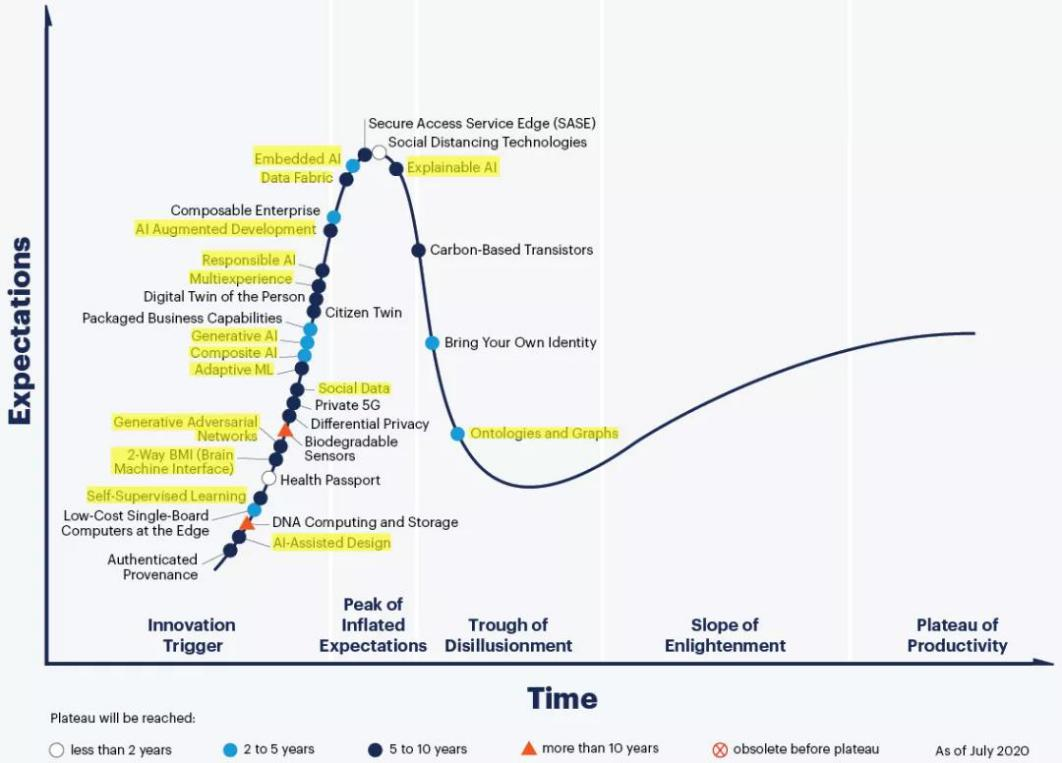2020 is a challenge year for the world to fight with COVID-19. However, the research of AI technology still has made remarkable breakthroughs. And its integration with the cybersecurity is also steadily emerging. How was the development of AI technology in this year? What are the new trends of AI technology and cybersecurity?
This paper will guide you with vertical industry insights.
The Popularity of AI Remains Is High
From the overall development of AI technology in 2020, whether in industry or in academia, attention to AI technology has continued to maintain its high fever in recent years, and even greater than in previous years.
In July 2020, Gartner released the Hype Cycle for Emerging Technologies, 2020. After investigating and analyzing 1,700 technologies, among 30 technologies were finally selected. Compared with the curve in 2019, there are 22 technologies that no longer appear or adjust, which can be described as huge changes. But still at least half of the technologies have direct connection with AI (marked in yellow in the figure below), received great interest in the industry. The AI-Assisted Design and AI-Augmented Development indicate that the collaborative working of AI and humans will gradually become popular in the future.

In academic research, the number of contributions to the AAAI (Association for the Advancement of Artificial Intelligence) reached a new high in 2020, exceeding 9,000 (8,800+ in 2019), which shows that the academic research in AI continues to rise.
There have been some influential research results in 2020, including the natural language processing model GPT-3 proposed by OpenAI containing 175 billion parameters, the chat robot Meena designed by Google, and the protein structure prediction algorithm AlphaFold2 launched by DeepMind. These achievements prove that the research of AI technology not only continues to advance at a high speed, but also begins to have a significant impact on the research of other disciplines (such as biology).
In addition, the AI technology has played an important role against the COVID-19, but it has also brought some controversies. For example, the combined of face recognition, infrared temperature measurement and door control systems have contributed a lot to the prevention and control of the pandemic. But the personal privacy protection also becomes an issue. The EU GDPR puts forward constraint for data collection under pandemic environment. Therefore, Germany has specially added some wordings to the GDPR to authorize the government to process personal data during pandemic, natural disaster or man-made disaster.
AI Empowers Cybersecurity to Advance Steadily
The rapid development of AI technology has also manifested itself in cybersecurity. The RSA Conference held in February 2020 was affected by the pandemic. The total number of exhibitors dropped from 736 in 2019 to 669. However, the number of exhibitors using AI/machine learning as keywords is basically the same as in 2019 (121 VS 124). The adoption and recognition of AI technology in cybersecurity are increasing.
Although the theme of the conference is "Human Element", it is closely related to AI technology. One of the most important notion is to combine AI technology with human offensive and defensive confrontation knowledge and experience, which improve the automation using AI and reduce the load of security analyst by introducing intelligent analysis into ATT&CK and other methods, achieving overall improvement of cybersecurity capabilities.
The most important thing in cybersecurity is not the newfangled and dazzled technologies, but the actual protection capabilities and outcomes. Accordingly, AI-enabled cybersecurity is gradually becoming pragmatic. Some specific development trends are as follows:
1.Based on an in-depth understanding of AI and its scope of application, AI will be adopted more in combination with other technologies in cybersecurity to give full play to the comprehensive advantages of technology.
2.In view of the characteristics of data in cybersecurity, unsupervised, self-supervised or semi-supervised methods will have more application prospects, while supervised methods are only suitable for a few scenarios with abundant labeled data samples.
3.The explainability of AI is receiving increasing attention in cybersecurity, but it is still a frontier scientific issue, which is no general efficient and reliable technology available for now.
4.The adoption of AI will give birth to more new types of use cases, like intrusion actor portrait, security knowledge graph, security analysis recommendation, etc.
5.With the help of AI, network intrusions are gradually emerging, and intrusions against AI weaknesses cannot be ignored. The cybersecurity is developing in the direction of intelligence in actual combat exercises.
In recent years, Venustech Group has been committed to transforming AI technology into practical cybersecurity capabilities. In 2020, it has achieved substantial progress in the application of artificial intelligence-based malicious domain name recognition, Trojan communication detection, behavior anomaly detection and others.
Future Outlook
In October 2020, Gartner released Top Strategic Technology Trends for 2021, one of which is "AI engineering" (as shown below). The report pointed out that AI projects often failed due to issues such as maintainability and scalability. And the composed of DataOps, ModelOps, and DevOps will help improve the performance, maintainability, scalability, explainability, and reliability of AI models. Thus, with the raising demand for AI to empower cybersecurity and technological development, systematic artificial intelligence engineering will become a more efficient way in the future.
Have a question? We're here to help.
Please send an email to overseas@venustech.com.cn
Or you can fill out the form below and we will get in touch with you soon.
Thank you for your interest in Venustech.